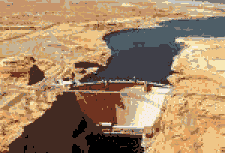What's Good - What's Bad - What's Next?
Large Dams
in the
Western United States
"No river should ever reach the sea." - Joseph Stalin
"Of all the ways to tamper with or harm a river, a large dam usually has the most immediate and far reaching effects..." - Lori Pottinger, International River Network
Introduction
If we consider the benefits achieved by impounding rivers and utilizing dammed waters for hydroelectric power production, industry, irrigation, or fishing and recreation, the validity of Stalin's statement appears accurate. However, though large dams are useful in many ways, they have also proved to be tragically destructive to both river and terrestrial ecosystems, as well as human cultures. In order to analyze both the positive and negative effects of dams we examine two case studies; the Bonneville Dam located on the Columbia River, and the Glen Canyon Dam found on the Colorado River. Our findings are divided into four subdivisions; Biological/Ecological, Sociological/Cultural, Legal/Political, and Economical.Visit our listing of the major positive/negative effects of the Bonneville and Glen Canyon dams. As you navigate through our web pages, and travel with us down the Columbia River, meet the Native American tribes whose culture and livelihoods have been ravaged by the Bonneville Dam. Sail down the Colorado River and visit the Glen Canyon Dam where endangered and extinct species once dwelled. Finally, journey to the future of large dams in the United States and decide what you can do to help eradicate the problems caused by large dams.
 |
|